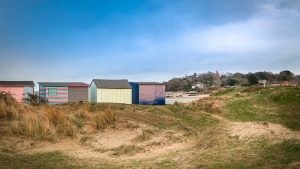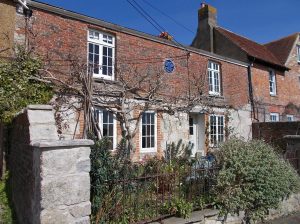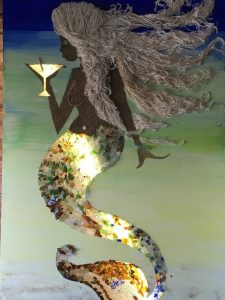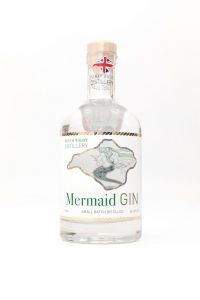 St Helen’s is an attractive English village that boasts rich tales of royalty and smugglers. It is centred on a long, broad green that sits high above St Helen’s Duver, on the eastern end of the Isle of Wight.
St Helen’s is an attractive English village that boasts rich tales of royalty and smugglers. It is centred on a long, broad green that sits high above St Helen’s Duver, on the eastern end of the Isle of Wight.
A duver – it rhymes with cover – is local lingo for an area of sand dunes. In the late nineteenth century, St Helen’s Duver was a golf course by the sea, and the Royal Isle of Wight Golf Club soon rivalled St. Andrew’s in Scotland. Making use of the existing sand dunes and shrubbery, turf was also brought down from Cumbria to create a popular nine-hole course that opened in 1882. It was originally a men’s only course, and Edward VII, then Prince of Wales, became its Patron and first President. His younger sister, Princess Beatrice, who was Governor of the Isle of Wight for many years, would later become President of the Club until her death in 1940.
The Club quickly became popular with politicians, celebrities and the extended Royal family, who often stayed with  Queen Victoria at her nearby island retreat, Osbourne House. Unfortunately, club membership diminished dramatically after World War 2 and the Club finally closed in the 1960s. It was decided by the remaining members to present the land to the National Trust. The original weatherboard clubhouse has been converted into an attractive and comfortable National Trust holiday cottage, where we stayed for a gloriously windy week in January. Now the golf course is common land, and popular with many local dog walkers… and ducks!
Queen Victoria at her nearby island retreat, Osbourne House. Unfortunately, club membership diminished dramatically after World War 2 and the Club finally closed in the 1960s. It was decided by the remaining members to present the land to the National Trust. The original weatherboard clubhouse has been converted into an attractive and comfortable National Trust holiday cottage, where we stayed for a gloriously windy week in January. Now the golf course is common land, and popular with many local dog walkers… and ducks!
***
Long before there was a golf course, there was a church just above the beach. The Church began to collapse in around 1550, as the coastline beneath it was eaten away by the sea. Today, only a portion of the Tower remains. It has been bricked up on the seaward side and painted white, for use as a sea mark, that identifies the approximate position of a maritime channel or hazard, so boats can navigate safely.
In the eighteenth century, a local fisherman gained notoriety here as a smuggler. Dickie Dawes was reputed to have hidden his contraband brandy and tobacco beneath the gravestones in the old churchyard, before hefting it through secret passages to the village and the Cluniac priory.
Dickie’s daughter, Sophie, was born in a small terraced house on the upper green of St. Helen’s in about 1795. A real rags-to-riches, Pygmalion-style story, Sophie was sent to the workhouse at Newport when her father died, but she would eventually find her way to the French court. After leaving the workhouse, she gained a position as a chambermaid in Portsmouth. Moving on to London, she was employed as a servant in a high-class brothel in Piccadilly. There, she met the exiled French Duke de Bourbon. Pretty and quick-witted, she soon became his mistress and protégée. Later, she followed him to Paris, where she became a minor celebrity in the court of Louis XVIII. The Duc arranged a dowry and a marriage of convenience to his military aide, but kept her as a lover, bequeathing her a title and, on his death in 1830, a large fortune. However, the circumstances of his death (he was discovered with a rope around his neck) and her subsequent inheritance, cast suspicions on the Baronne de Feuchères, and she was forced to flee back to England, where she died a decade later, still entangled in legal squabbles about her inheritance.
rags-to-riches, Pygmalion-style story, Sophie was sent to the workhouse at Newport when her father died, but she would eventually find her way to the French court. After leaving the workhouse, she gained a position as a chambermaid in Portsmouth. Moving on to London, she was employed as a servant in a high-class brothel in Piccadilly. There, she met the exiled French Duke de Bourbon. Pretty and quick-witted, she soon became his mistress and protégée. Later, she followed him to Paris, where she became a minor celebrity in the court of Louis XVIII. The Duc arranged a dowry and a marriage of convenience to his military aide, but kept her as a lover, bequeathing her a title and, on his death in 1830, a large fortune. However, the circumstances of his death (he was discovered with a rope around his neck) and her subsequent inheritance, cast suspicions on the Baronne de Feuchères, and she was forced to flee back to England, where she died a decade later, still entangled in legal squabbles about her inheritance.
Today, she is remembered by a simple blue plaque on the house of her birth and the nickname the Queen of Chantilly, after one of her lover’s properties.
***
 A couple of miles north of St. Helen’s, a once-popular pub at Pondwell has recently metamorphosed into The Mermaid, a bright and airy home for the Isle of Wight Distillery and its new cocktail bar. We popped in to try its latest concoctions and to look at the beautiful gin stills with their flute-like pipes, set up in what used to be the pub kitchen. The weather was a little chilly, but the large deck at the rear, overlooking vineyards and a glimpse of the sea, will provide a wonderful summer destination. Pete Muspratt welcomed us enthusiastically, and offered to take us through the story of the Isle of Wight Distillery, followed by a tasting of their products.
A couple of miles north of St. Helen’s, a once-popular pub at Pondwell has recently metamorphosed into The Mermaid, a bright and airy home for the Isle of Wight Distillery and its new cocktail bar. We popped in to try its latest concoctions and to look at the beautiful gin stills with their flute-like pipes, set up in what used to be the pub kitchen. The weather was a little chilly, but the large deck at the rear, overlooking vineyards and a glimpse of the sea, will provide a wonderful summer destination. Pete Muspratt welcomed us enthusiastically, and offered to take us through the story of the Isle of Wight Distillery, followed by a tasting of their products.
The distillery was set up in 2014 by experienced wine and beer makers, Xavier Blake and Conrad Gauntlett. Old friends, they were keen to expand their business and have successfully ridden the wave of the latest drinking trend: gin.
Mermaid Gin is a smooth and sophisticated gin made from a barley-based spirit from Manchester and ten botanicals, many locally sourced. We followed the recipe with interest: coriander is grown across the Solent in Sussex and the citrusy Boadicea hops come from Ventnor’s Botanical Gardens, on the southern side of the island. The rock samphire, known locally as Mermaid’s Kiss (hence the name of the gin), also grows on the cliffs in the south. Peter lets us dip our finger into a testing jar of liquorice powder, which is surprisingly sweet, while the oris root, used as a fixative, has a flavour reminiscent of camomile tea. Then there is elderflower, Sicilian lemons and the unexpectedly peppery Grains of Paradise from Ghana. With the popularity of boutique gin distilleries on the mainland, the Isle of Wight Distillery has had to plant its own juniper bushes in the vineyard, and in the meantime, they import the berries they need from Macedonia.
The botanicals are mixed together and steeped for 24 hours to release all the essential oils. The spirit rests for seven days to ‘allow the flavours and aromas to mellow and marry together.’ The result is described as a ‘smooth, refreshing, and complex gin with a contemporary style’ with a nose of ‘fresh citrus, sweet spice, gentle juniper.’ Pete suggests that it is best drunk with Fever Tree’s elderflower tonic water.
days to ‘allow the flavours and aromas to mellow and marry together.’ The result is described as a ‘smooth, refreshing, and complex gin with a contemporary style’ with a nose of ‘fresh citrus, sweet spice, gentle juniper.’ Pete suggests that it is best drunk with Fever Tree’s elderflower tonic water.
The HMS Victory Navy Strength Gin, named for Nelson’s warship, is aged in oak barrels from the famous ship, in partnership with the National Museum of the Royal Navy. It has a higher concentration of botanicals than the Mermaid gin, giving it a greater intensity of flavour. In the 18th century the Royal Navy ruled that all naval ships were to carry gin on board that had to be 100° proof – the English standard of the day – which equates to 57% ABV, or alcohol by volume. It was discovered that gunpowder soaked in alcohol stronger than 57% could still be ignited, and this became the standard test for Navy Strength or ‘gunpowder proof’ gin. A percentage of the sales apparently goes to support the ongoing restoration of the HMS Victory.
Apart from these two gins, the Distillery also laid down its first barrel of Whiskey in 2015, which is almost ready to be launched on the world.
Rock Sea Vodka is a grain distilled Isle of Wight vodka, with a subtle addition of rock sea salt for smoothness and a sense of salt on your lips after a day at the beach.
And finally, a dark rum: HMS Victory Rum is a blend of aged demerara rum from Guyana, Trinidad and Jamaica. It is, so Pete tells us, reminiscent of the taste of traditional ‘rum tots’ issued on board naval ships. The rum has been refined and rested in oak barrels using an oak stave from HMS Victory herself, which adds a depth of character. The One & Only, a keen rum drinker, was delighted with the Victory rum. I preferred the Mermaid Gin, though, and went home happily with a bottle.

Love your writing Ally Thankyou for sharing it
Thanks Holly xx
You’re welcome!